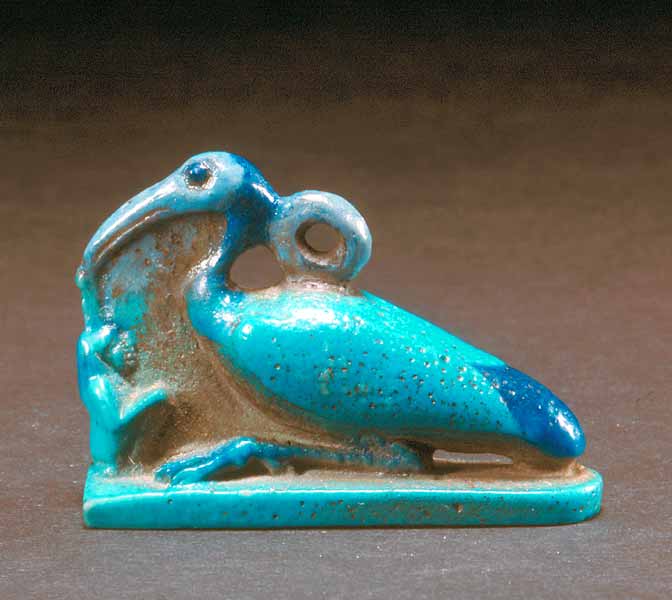Faience Amulet Depicting Thoth as an Ibis and Maat, 664 BCE - 332 BCE
Faience
1
X.0119
Faience, which dates back to pre-dynastic times, of at least 5,000 years, is a glasslike non-clay substance made of materials common to Egypt: ground quartz, crushed quartz pebbles, flint, a...
Faience, which dates back to pre-dynastic times, of at least 5,000 years, is a glasslike non-clay substance made of materials common to Egypt: ground quartz, crushed quartz pebbles, flint, a soluble salt-like baking soda, lime and ground copper, which provided the characteristic color. The dried objects went into kilns looking pale and colorless but emerged a sparkling "Egyptian blue." Called tjehnet by the ancient Egyptians, meaning that which is brilliant or scintillating, faience was thought to be filled with the undying light of the sun, moon and stars and was symbolic of rebirth. In the cultural renaissance of the 26th Dynasty, also known as the Saite Period (when work was produced), a green, the color of the Nile and evocative of the verdant landscape in springtime, was particularly popular.
The ibis was a sacred bird in Ancient Egyptian mythology, most closely identified with the moon god Thoth, the messanger of the sun god Ra, who is often represented as an ibis-headed man or as a baboon. The name “Thoth” is actually the Greek term used to refer to this deity, whom the Greeks closely identified with Hermes, their messenger to the gods. Thoth, like Hermes, was credited as the inventor of astronomy, writing, and mathmatics. Here, Thoth is represented as an ibis, gorgeously rendered with dark blue glazed highlights added to his eyes, claws, and tail feathers. In front of the bird, just below his arching beak, a crouching woman is present. She can be identified as Maat, the wife of Thoth, recognizably by the relatively large ostrich feather that crowns her head. Maat was the personification of the fundamental order of the universe, without which all of creation would perish.
This diminutive pendent is a masterpiece of intricacy. Originally, this ancient statuette would have been worn as a pendant hung on a necklace, as is evident from the ribbed suspension loop present on the bird’s back. Surely, given the symbolic significance of these two deities and the intricate detail of the carving, this pendant would have been worn by an elite member of Ancient Egyptian society. Certain objects, masterpieces treasured in their own time, are of an eternal beauty that is easily appreciated regardless of era or culture. This pendant is one such stunning example; a reminder of the tremendous splendor humanity is able to create when at the apex of a great civilization.
The ibis was a sacred bird in Ancient Egyptian mythology, most closely identified with the moon god Thoth, the messanger of the sun god Ra, who is often represented as an ibis-headed man or as a baboon. The name “Thoth” is actually the Greek term used to refer to this deity, whom the Greeks closely identified with Hermes, their messenger to the gods. Thoth, like Hermes, was credited as the inventor of astronomy, writing, and mathmatics. Here, Thoth is represented as an ibis, gorgeously rendered with dark blue glazed highlights added to his eyes, claws, and tail feathers. In front of the bird, just below his arching beak, a crouching woman is present. She can be identified as Maat, the wife of Thoth, recognizably by the relatively large ostrich feather that crowns her head. Maat was the personification of the fundamental order of the universe, without which all of creation would perish.
This diminutive pendent is a masterpiece of intricacy. Originally, this ancient statuette would have been worn as a pendant hung on a necklace, as is evident from the ribbed suspension loop present on the bird’s back. Surely, given the symbolic significance of these two deities and the intricate detail of the carving, this pendant would have been worn by an elite member of Ancient Egyptian society. Certain objects, masterpieces treasured in their own time, are of an eternal beauty that is easily appreciated regardless of era or culture. This pendant is one such stunning example; a reminder of the tremendous splendor humanity is able to create when at the apex of a great civilization.



